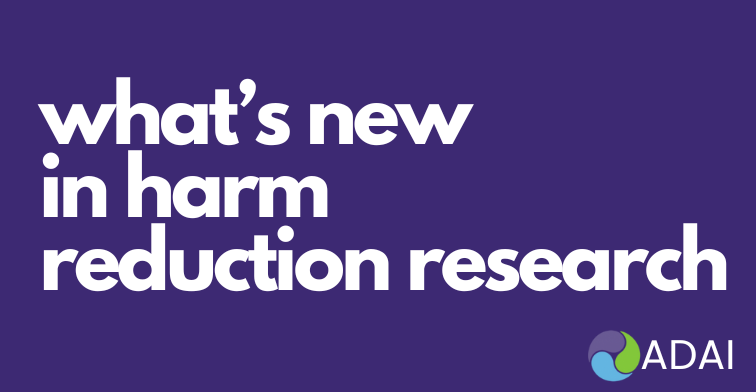What’s New in Harm Reduction Research: Focus on Methamphetamine (February 2025)
02/03/2025Special Focus: Harm Reduction and Methamphetamine

Need help getting copies of any of these articles? Email Meg Brunner, MLIS (meganw@uw.edu). Free articles have “(open access)” after the titles; all other articles require a subscription to access.
Harm reduction approaches
I don’t want to shoot up the meth anymore: Pipe distribution as a harm reduction service for people who use methamphetamine.
Rains A, Augustine E, Miller K, Bresett J, Bolinski R, Thompson T, Ajayi BP, Nicholson W, Fletcher S, Jenkins WD, Pho MT, Ouellet LJ, Ezell JM. Subst Use Misuse 2024;19:1-8.
Semi-structured interviews in rural southern Illinois with 19 people who used methamphetamine explored attitudes and behaviors regarding pipe use practices and pipe access. 100% had smoked and 84% had injected meth in the past 30 days. Participants reported smoking instead of injecting to decrease wounds, pain, and infections. Smoking enabled some to use with others around versus using alone when they injected. Participants felt pipe distribution would also help connect people to other services such as HIV testing, naloxone, and safer sex supplies.
Safety strategies and harm reduction for methamphetamine users in the era of fentanyl contamination: A qualitative analysis. (open access)
Erinoso O, Daugherty R, Kirk MR, Harding RW, Etchart H, Reyes A, Page K, Fiuty P, Wagner KD. Int J Drug Policy 2024;128:104456.
Interviews with 48 adults in Nevada and New Mexico who used methamphetamine on how they mitigated risks when using meth in the context of illicit fentanyl. Strategies included buying from trusted sources, using fentanyl test strips, and “spotting” (using with someone nearby). Participants often reduced their use of meth and used other substances (e.g., marijuana, alcohol) to counter unwanted side effects of meth (e.g., hallucinations, paranoia). Harm reduction behaviors were influenced by multilevel risk environments, which include social, physical, economic, and political factors.
Unmet needs and harm reduction preferences of syringe services program participants: differences by co-use of illicit opioids and methamphetamine. (open access)
Sun R, Sauda TH, Hoopsick RA. Harm Reduct J 2024;21(1):119.
This study examined differences between SSP participants who do and do not co-use illicit opioids and methamphetamine. Unmet needs were prevalent, and the desire for more harm reduction services was high among people who inject drugs. All participants were interested in fentanyl test strips, safe consumption sites, and delivery of syringe service supplies including naloxone. Those who co-used opioids and meth had a greater need for food, healthcare, substance use disorder treatment, a support person to help access services, and bus passes or transportation.
Exploring the potential of Self-Management and Recovery Training (SMART Recovery) mutual-help groups for supporting people who use methamphetamine: A qualitative study examining participant experience of initiation and engagement. (open access)
Beck AK, Larance B, Manning V, Deane FP, Baker AL, Hides L, Shakeshaft A, Argent A, Kelly PJ. J Subst Use Addict Treat. 2024 Nov 6;169:209570.
This study examined how people who use methamphetamine engaged with SMART Recovery mutual-help groups. Participant initiation of SMART Recovery groups was described across two themes: 1) delayed attendance, and 2)use as an adjunct to other services. Engagement was influenced by: 1) the ‘fit’ of SMART Recovery mutual-help groups; 2) coping and tolerance of discomfort; 3) the power of shared lived experience; 4) choice and autonomy; and 5) short-term goal setting supports. Offering choice of mutual-help groups including SMART may help people engage and connect with services.
Cannabis use to manage stimulant cravings among people who use unregulated drugs. (open access)
Reddon H, Socias ME, DeBeck K, Hayashi K, Walsh Z, Milloy MJ. Addict Behav 2024;148:107867.
297 individuals in Vancouver, Canada who concurrently use cannabis and unregulated stimulants were surveyed about how they use cannabis to manage stimulant cravings and/or make changes in stimulant use. 45% used cannabis to manage stimulant cravings. 78% of these participants reported decreasing their stimulant use during periods of cannabis use. Cannabis use to manage stimulant cravings was significantly associated with reduced stimulant use among people who used meth daily but not among people who used crack/cocaine daily.
“Jail isn’t the answer for these inmates”: how to respond to methamphetamine use in prisons.
Ricciardelli R, Johnston MS, Maier K, Ferguson L. Int J Prison Health 2024;20(3):327-343.
269 correctional workers in Manitoba, Canada were surveyed about challenges of responding to meth use among incarcerated individuals and meth’s impact on staff well-being. Correctional workers believed policies/protocols for managing meth use and withdrawal are inadequate. They reported monthly contact with incarcerated individuals experiencing meth withdrawal that posed safety concerns to them and other incarcerated individuals. Staff desired more training on managing meth withdrawal, more nurses for medical intervention, and addiction support programming.
Experiences in emergency departments/hospitals
Emergency room utilization and methamphetamine overdose symptoms among syringe services program participants in Washington State.
Frank ND, Banta-Green CJ, Guthrie BL, Kingston S, Tinsley J, Whiteside L, Glick SN. Subst Use Misuse 2024;59(7):1012-1019.
This study used data from the 2021 WA State Syringe Services Program Health Survey to describe participant experiences with methamphetamine overdose symptoms (MOS) including severe psychological and physical health issues like psychosis and heart attack. 86% had used meth in the last 3 months, among whom 31% reported psychological MOS, 19% reported physical MOS, and 37% reported ≥1 MOS in the prior 3 months. Non-fatal opioid overdose, main drug of goofball (heroin and meth combined), and recent blood infection/sepsis were associated with ER utilization for MOS.
Bridging the gap; examining emergency service providers’ experiences caring for patients with methamphetamine-induced behavioural disturbance. Wiens B, Beaven J, Williams E, Viste D, Ghosh SM, Stokvis C, Lemma B, Rioux W, VandenBerg S. Am J Emerg Med 2024:S0735-6757(24)00671-5.
162 multidisciplinary emergency providers in the Calgary area were surveyed on their experiences working with patients exhibiting meth-induced behavioural disturbances (MIBD). Providers reported that meth side effects and the unpredictability of MIBD contributed to persistent unease and fear of safety for staff and patients. 85% reported feeling unsafe and 83% had encountered harm. Feeling unsafe and a perceived lack of resources contributed to moral distress and poor patient care. However, staff still felt empathy for these patients: “Opioids are rightly considered a crisis, but I believe meth is a parallel, less obvious one that we will pay dearly for in the long run”.
Perceptions of stigma among people with lived experience of methamphetamine use within the hospital setting: qualitative point-in-time interviews and thematic analyses of experiences.
Forchuk C, Serrato J, Scott L. Front Public Health 2024;12:1279477.
104 individuals in Southwestern Ontario, Canada with past or current meth use were interviewed about their experiences of stigma in hospitals. Participants described feeling shunned or less worthy than other patients due to 1) medical staff belief that substance use is a moral and personal choice rather than a health condition, and 2) social stigmas such as income, housing and substance use. Participants felt this stigma from healthcare workers led to inadequate treatment or pain management.
“If you plant that seed, it will grow”: A qualitative study to improve linkage to care among patients with methamphetamine use disorder in emergency department settings.
Rinehart DJ, Duarte KG, Gilbert A, Al-Tayyib A, Camfield K, Simpson SA. J Addict Med 2024;18(6):628-634.
18 patients with methamphetamine use disorder were surveyed about their experiences in emergency departments (ED) in Denver, Colorado. Participants described feeling stigmatized and experiencing a lack of communication from ED staff who often did not take their health concerns seriously once substance use was identified. Participants were uncertain about overdose risk and felt their psychiatric symptoms complicated treatment. Referrals to treatment were lacking. Participants were interested in care navigation services, contingency management, and ED staff being empathetic, trauma-informed, and flexible regardless of patient readiness to seek treatment.





